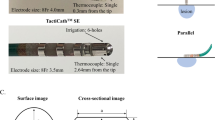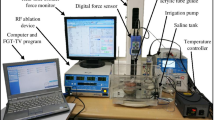Abstract
Background: Prior studies have found that there is a widespread practice of catheter reprocessing in cardiac electrophysiology laboratories. Effects of reprocessing of ablation catheters on temperature sensing and mechanical deflection are not fully known.
Methods: Twenty-four new and used ablation catheters were studied. Deviation of temperature sensing by catheters from the temperature of a heated saline bath was measured. The angle of deflection of digitally scanned catheters at 75% and 100% handle deflection was also measured. New and used catheters were compared with respect to their temperature sensing accuracy and deflection characteristics.
Results: Overall, there was 0.7 ± 0.1°C (mean ± standard error) deviation of the sensed temperature from the bath temperature, with no significant difference between new and used catheters. Similarly, there was no significant difference in the angle of deflection between new (66.7° ± 6.2° and 24.3° ± 6.8° at 75% and 100% deflections, respectively) and used (59.6° ± 5.6° and 28.7° ± 9.9° at 75% and 100% deflections, respectively) catheters. The difference in the angle of deflection between matched new and used catheters was 18.9° ± 4.2° and 10.9° ± 2.4° at 75% and 100% deflections, respectively, with a relatively broad range (5.0°–35.6° and 0.4°–19.0° at 75% and 100% deflections, respectively).
Conclusions: This study found no significant overall difference in temperature sensing accuracy and deflection angle of new and used ablation catheters. Nevertheless, individual differences in deflection characteristics between new and used catheters are occasionally seen and warrant screening of reprocessed catheters prior to their reuse.
Similar content being viewed by others
References
Dunnigan A, Roberts C, McNamara M, Benson DW Jr, Benditt DG. Success of re-use ofcardiac electrode catheters. American Journal of Cardiology 1987;60:807–810.
O'Donoghue S, Platia EV.Reuse of pacing catheters: A survey of safety and efficacy. Pacing & Clinical Electrophysiology 1988;11:1279–1280.
Ross DL. Re-use of electrode catheters labelled as single use for clinical cardiac electrophysiological studies.Australian & New Zealand Journal of Medicine 1996;26:632–635.
Gilligan DM, Wood MA, Ellenbogen KA. Catheter reuse: Boon or boondoggle? Pacing & Clinical Electrophysiology 1998;21:2558–2562.
Charatan F. Controversy erupts over reuse of “single use” medical devices. BMJ 1999;319:1320.
Mickelsen S, Mickelsen C, MacIndoe C, Jaramillo J, Bass S, West G, Kusumoto F. Trends and patterns in electrophysiology and ablation catheter reuse in the United States. American Journal of Cardiology 2001;87:351–353.
Avitall B, Khan M, Krum D, Jazayeri M, Hare J. Repeated use of ablation catheters: A prospective study.Journal of the American College of Cardiology 1993;22:1367–1372.
Blomstrom-Lundqvist C. The safetyof reusing ablation catheters with temperature control and the need for a validation protocol and guidelines for reprocessing. Pacing & Clinical Electrophysiology 1998;21:2563–2570.
Bathina MN, Mickelsen S, Brooks C, Jaramillo J, Hepton T, Kusumoto FM. Safety and efficacy of hydrogen peroxide plasma sterilization for repeated use of electrophysiology catheters. Journal of the American College of Cardiology 1998;32:1384–1388.
Aton EA, Murray P, Fraser V, Conaway L, Cain ME. Safety of reusing cardiac electrophysiology catheters. American Journal of Cardiology 1994;74:1173–1175.
Ferrell M, Wolf CE, 2nd, Ellenbogen KA, Wood MA, Clemo HF, Gilligan DM. Ethylene oxide on electrophysiology catheters following resterilization: Implications for catheter reuse. American Journal of Cardiology 1997;80:1558–1561.
Grimandi G, Sellal O, Grimandi F, Crochet D.Risks of reusing coronary angioplasty catheters: Results of an experimental study. Catheterization & Cardiovascular Diagnosis 1996;38:123–130.
Luijt DS, Schirm J, Savelkoul PH, Hoekstra A. Risk of infection byreprocessed and resterilized virus-contaminated catheters; an in vitro study. Europian Heart Journal 2001;22:378–384.
Turi ZG. Reuse of disposables: Let's not embrace waste. Catheterization & Cardiovascular Diagnosis1996;38:133–134.
Fagih B, Eisenberg MJ. Reuse of angioplasty catheters and risk of Creutzfeldt-Jakobdisease. American Heart Journal 1999;137:1173–1178.
Barbeau GR. Reuse of coronary catheters: Oldquestions, new environment. American Heart Journal 1999;137:1010–1011.
Lindsay BD, Kutalek SP, Cannom DS, Hammill SC, Naccarelli GV. Reprocessing of electrophysiology catheters: Clinical studies, regulations, and recommendations. A report of the NASPE Task Force on Reprocessing of Electrophysiological Catheters. Pacing & Clinical Electrophysiology 2001;24:1297–1305.
Mak KH, Eisenberg MJ, Eccleston DS, Brown KJ, Ellis SG, Topol EJ. Cost-efficacy modeling of catheter reuse for percutaneous transluminal coronary angioplasty. Journal of the American College of Cardiology 1996;28:106–111.
Lesh MD. Cost efficacy modeling of catheter reuse forpercutaneous transluminal coronary angioplasty. Journal of the American College of Cardiology 1996;28:1640–1641.
Brook CW. Re-use of electrode catheters labelled as single use. Australian & New Zealand Journal of Medicine1997;27:353–355.
Krause G, Dziekan G, Daschner FD. Reuse of coronary angioplasty balloon catheters:Yes or no? European Heart Journal 2000;21:185–189.
Author information
Authors and Affiliations
Rights and permissions
About this article
Cite this article
Ayzman, I., Dibs, S.R., Goldberger, J. et al. In Vitro Performance Characteristics of Reused Ablation Catheters. J Interv Card Electrophysiol 7, 53–59 (2002). https://doi.org/10.1023/A:1020820200112
Issue Date:
DOI: https://doi.org/10.1023/A:1020820200112




